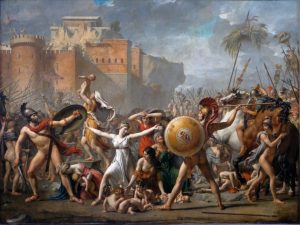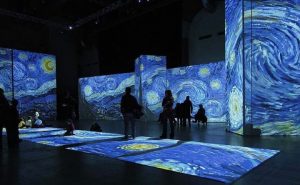Formal analysis is how we can examine and understand art to the smallest details by seeing how the artist used their techniques to create their works. Using formal analysis involves things such as the composition, lines, color, and texture. Using these characteristics many artist use them to help us paint our own picture of what the artist is conveying. We see in todays world how advertisements use formal and contextual analysis to the fullest with how they want us to decipher their message. We see to this day how the color, scale, and composition makes us perceive works of art and define it in our own way. We as well use formal analysis when it comes to performance art from the movement, gestures, and sounds that the artist uses. Formal analysis helps us break down works and brings us to our own understandings of things from the theater to sculptures and to advertisements we see everyday.
Tag: Blog Post 4: Formal Analysis
Formal Analysis

Formal Analysis is interpreting what the artist is trying to say visually through the color, scale, lines, space and mass. It’s an explanation of visual structure, in which certain visual elements have been arranged and the function within a composition.
Color has three main characteristics. The hue colors such as red, green, blue, etc. The value, in terms of how light or dark it is. And the intensity, how bright or dull it is. Colors can be described as warm colors which are red, yellow or cool (blue, gray), depending on which end of the color spectrum they fall.
Shape and form define objects in space. Shapes have two dimensions, height and width are usually defined by lines. Forms exist in three dimensions, with height, width, and depth. The scale of the piece can also be important as the size of the piece can emphasize or deemphasize certain elements in the piece. These elements of art are components or parts of a work of art that can be isolated and defined. They are the building blocks used to create and analysis a work of art.
Formal Analysis

Formal analysis is the way you describe a visualization through the use of colors, lines, contrast, position, material, illusion, space and mass. You can use colors because the pallet that the author chose to use in his painting can help determine the mood that the painter was feeling. You can use the the size of certain objects to see the importance of the item to the artist see if they saw it as important. The way things are modeled in a painting are important because you will be able to see how the artist intended for something to be looked at.
Formal Analysis
When an individual is prompted with the task of creating a formal analysis on a piece of work, it is meant that they should observe the physical factors that make up the piece.
Components of a formal analysis include everything to do with what you see as soon as you set sight on a piece and do not require further research. You may observe the lines, the colors and the size and scale of the piece. Are the lines going straight up or horizontal? There might possibly be a color scheme going on or maybe a pattern. Is the subject large or small? Is it possible to determine how large or small the subjects are to its surroundings? In addition, you may take how the subject is placed and it’s surrounding details into consideration and this may be called composition.
:max_bytes(150000):strip_icc()/elements-of-composition-in-art-2577514-v3-5b5b6c73c9e77c002c93c6de.png)
Formal Concept Analysis (FCA)
Formal analysis is a convenient catalog of the methodology used to analyze and define art solely based on a work’s inherent qualities. ‘Inherent qualities’ meaning: the creator’s intentions aside, what can be determined about some work of art (primarily visual pieces) from that work. Among the catalog of methodology are–in no particular order–the use (and absence) of color; the solidity of the lines and framework; the conveyance of three-dimensional space or lack thereof; the scale of the visuals.
Formal Analysis
As a modern society everyone is exposed to images and pictures in whatever modern device they are using. However people cannot really take in an image and break it down in order to fully understand all its elements that is made out of. In art history the method to analyze an image is called Formal Analysis. Formal Analysis is used to describe a work of art and more than analyzing what the image means, the concept focuses on what elements were used in order to make the work of art. Some of these elements are, composition, tone, colors, lines, depth, lighting, scale, modeling, material, texture and historical context. This elements are helpful when looking at art because it helps the view understand why the artist used them in the first place.

What is Formal Analysis?
Formal Analysis is describing visually and emphasizing the formal elements of an art piece and it’s important to note that every little detail has a reason as to why it’s there. Formal analysis affects what the art piece represents. The ‘how’ and the ‘why’ when it comes to art include interpretations on visual evidence which come from formal analysis. Formal analysis is a RE/presentation when it comes to analyzing the formal elements of the art piece.
The properties of formal analysis include:
- Line composition- lines can be horizontal, vertical, straight, curved, thick or thin. This leads our eyes around the composition and show character and direction.
- Texture- (ex. let’s say an art piece has a picture of a man wearing a shirt and you are able to tell the material of the shirt he is wearing)
- Color- neutral or bright colors which can show dullness
- Size/scale
- Modelling- chiaro/scuro (illisionism)
- Material- the tools used
- Contrast
- Position -> composition
- Mimesis, which means realistic
All of these elements bring out the meaning and evaluation of the art work. These components are the artist’s choices, everything is intentional & no detail is insignificant or not worth mentioning ! The bottom line is that the question that formal analysis answers is “What do you see in this piece of art?“

Blog Post 4: Formal analysis

Formal analysis is basically to look at a work of art and trying to understand what the artist wishes to convey visually. And even after analyzing it, it will most likely not what the artist wants to convey because the viewer would interpret it based on who they are. As a person living in a certain place and time with their own experiences. Formal analysis looks at certain basic traits in an artwork. They are color, line, space, mass and scale.
To analyze color, you first look at the particular colors of the piece. You also look at the characteristics of each color used, like the saturation or the shade. Maybe the specific colors are referring to a event, action, or concept. Some examples are if a piece is predominantly white, it can stand for purity, or it could also mean the blinding light of a rising sun. When looking at lines, we are looking for how a the lines are formed. Are they emphasizing light and dark, is the line contour strong and continuous, fuzzy and soft. Are they broken up into many pieces to give you a lack of shape? How complex or simple is the silhouette?
Space indicates whether an image conveys a sense of three dimensional space. Is the artwork create a sense of depth it’s landscape or setting, like you can walk inside of it? Or is it lacking in depth, like a brick wall? Mass is the space created by the artwork. Meaning the artwork conveys a sense of weight or volume. For example, the work may be showing an extreme close up of an eye, making it seem like an giant is looking right through. Scale is also important. You consider the presentation of size portrayed in the work or in relation to the viewer. Does the size mean anything. Some examples are large statues representation their importance, or a large paintings to make it feel like you are in the work. The term composition is how an artist puts all of these elements together in their piece.
You may never understand what the artist wants to convey fully, and you may have the completely wrong idea even after formal analysis. But it help you understand that an art piece is deeper than it really looks and it is beyond just a thing someone made. And one of arts main purpose is for you to interpret and ponder what the art is really trying to get at.
What is Formal Analysis?
Formal Analysis is a method of evaluating a piece of work. The work can be literally anything. The formal analysis of an art piece for example can be a way to evaluate the piece’s central theme or focus. Through formal analysis of an art piece, we can describe multiple characteristics of the art work such as the colors used, the type of canvas used, contrast, the historical context of the art work, and also the scale and size of the art piece. Another important feature of formal analysis is that we are supposed to ask ourselves important questions. For example, “what was the artist going through at time of painting this piece?” Another question might be: “Is this painting for another person at the time or was it painted by the artist to convey a certain message or theme?” You can also dive deep into the historical context of the painting and learn about the politics, culture, religion, or the economics during the time of the artist’s life. The Formal Properties of art work as discusses in class and the text include the lines used in work. The motive behind the size and scale of the work. The type of material of the canvas as mentioned before is another formal property. Other formal properties can be the illusions used (Mimesis). And lastly, the historical overview of the piece of work as mentioned before. For example, the formal properties of the featured art work, “The Starry Night,” by Vincent van Gogh would involve: Colors are mostly blue, black, and yellow, it is an oil on canvas, the time of drawing is 1889 which inspired him to pursue a post-Impressionism-type painting.
Formal Analysis

Formal Analysis is when you look and think about a painting or artwork carefully and consist of different ideas and perspective. Trying to understand what the artist is drawing or painting. Why did the artist draw or paint this way? There are certain basic elements of work of art that can be the focus in formal analysis. Therefore, it can be color, line, space and mass, and scale. Which is called the composition of how an artist put together all these elements.
The color is the first step where people take to look at and identify the different hues such as pink, purple, red soon. However, we can determine it by the primary colors and secondary colors. Next, a line can be determined by a three dimensional or a two dimensional. To show how thick or thin, horizontal, vertical, digital, or curved.
Space can indicate whether an image conveys a certain dimensional space. While mass describes its height, weight, and volume. We can say how tall or how heavy something is. How much space will it take up? Last, you want to look at the scale or size for a certain painting or drawing. Not just art has composition but also sculpture or architecture.
Formal Analysis

In our day-to-day lives we see various images that we glance at and rarely think about ever again. However, these images and other pieces of art that we come across usually have something specific that they are trying to convey. To maintain a better understanding of an art-piece, people often use a technique referred to as formal analysis. This method is used to analyze only what the artist provides the audience with visually in their piece rather than also referring to outside information or historical context. Instead of simply describing what can be seen, formal analysis requires interpreting an artist’s choice of colors, lines, space, scale, modeling, etc. These things and the various ways they can be used let the audience know what the artist wants to get across. These things can help us see what the artist is emphasizing, what the mood of the piece is, and what kind of emotions they wanted to evoke. In a way, using formal analysis can help a person to really think about and appreciate something they normally may not.



